Muck diving in Lembeh is a special kind of underwater experience. Instead of exploring coral reefs or looking for big sea animals, you search for tiny, unusual creatures hiding in the sand. This is what makes the Lembeh Strait so famous, with how much life is packed into its quiet seabeds.
The calm water and black volcanic sand in Lembeh create the perfect setting for spotting rare marine life and capturing close-up photos. From frogfish and seahorses to nudibranchs and tiny cuttlefish, there’s something new to discover on almost every dive. This guide will help you discover the top muck dive sites and what makes each one worth exploring!
What is Muck Diving?
Muck diving is the kind of diving where you explore seabeds made of sand, silt, or rubble. These places may look empty at first, but they hold a surprising amount of life. Many rare and strange creatures live here, hiding in plain sight.
Because they’re so well camouflaged, muck diving is slow and careful. Divers move gently, scanning the ground for signs of movement. A piece of seaweed might be a seahorse. A bottle might hold an octopus. The goal is to find what others miss.
What makes it special is not just the creatures, but what they do. You might see a shrimp cleaning a fish, a cuttlefish flashing colors, or two nudibranchs in a mating dance. These close-up moments are what make muck diving unforgettable.
Where Is Lembeh and Why Is It So Famous?

Lembeh Strait is a narrow stretch of water in North Sulawesi, Indonesia, between the Sulawesi mainland and Lembeh Island. It’s famous for muck diving because no other place offers such a high chance of finding rare marine life in one small area.
The reasons go deeper than location. The strait’s black volcanic sand makes a perfect hiding place for camouflaged creatures and creates a strong contrast for photography. Gentle currents carry nutrients from the deep ocean, feeding a wide range of life. These calm, rich conditions help even the most unique animals survive, turning Lembeh into a hotspot for tiny, strange, and hard-to-find species.
What Critters Can You Encounter In Lembeh?
Lembeh is packed with unique and wonderful marine life. Some creatures are tiny, some are colorful, and many are so well hidden you’d swim right past them without a guide. Here’s a quick look at some of the stars you might see:
- Frogfish: Lembeh is known to have a diverse species of frogfish, including Hairy, Painted, Giant, and more. You’ll see them sitting still, pretending to be rocks or sponges, waiting to gulp down anything that comes too close.
- Octopuses and Cuttlefish: This is one of the few places where you can spot the Mimic, Wunderpus, Coconut Octopus, Blue-Ringed Octopus, and even Flamboyant Cuttlefish, all in one trip if you’re lucky.
- Nudibranchs: Bright, interesting, and photogenic nudibranchs can be found almost anywhere in Lembeh. You can easily find dozens of species almost every time you get into the water.
- Scorpionfish: These are bottom-dwelling predators known for their excellent camouflage and venomous spines. In Lembeh, you might see Rhinopias, Ambon Scorpionfish, and even the rare Stonefish. They stay still for long periods, which makes it easy to take a picture of them.
- Shrimp and Crabs: Lembeh is home to a wide range of fascinating crustaceans. You can spot Harlequin Shrimp feeding on starfish, tiny Hairy Shrimp floating among the rubble, and powerful Peacock Mantis Shrimp known for their lightning-fast strike.
- Seahorses and Pipefish: From tiny Pygmy Seahorses to Ghost Pipefish and even the rare Lembeh Seadragon, this is a great place to find the hard-to-find seahorse and pipefish species.
Diving in Lembeh feels like a scavenger hunt. You never know what’s hiding in the sand, but chances are, it’s something memorable.
5 Best Dive Sites for Muck Diving in Lembeh Strait
Almost every dive in Lembeh has something special to offer, but some sites stand out for their critter variety and reliable sightings. These are the ones divers ask for again and again:
1. Hairball
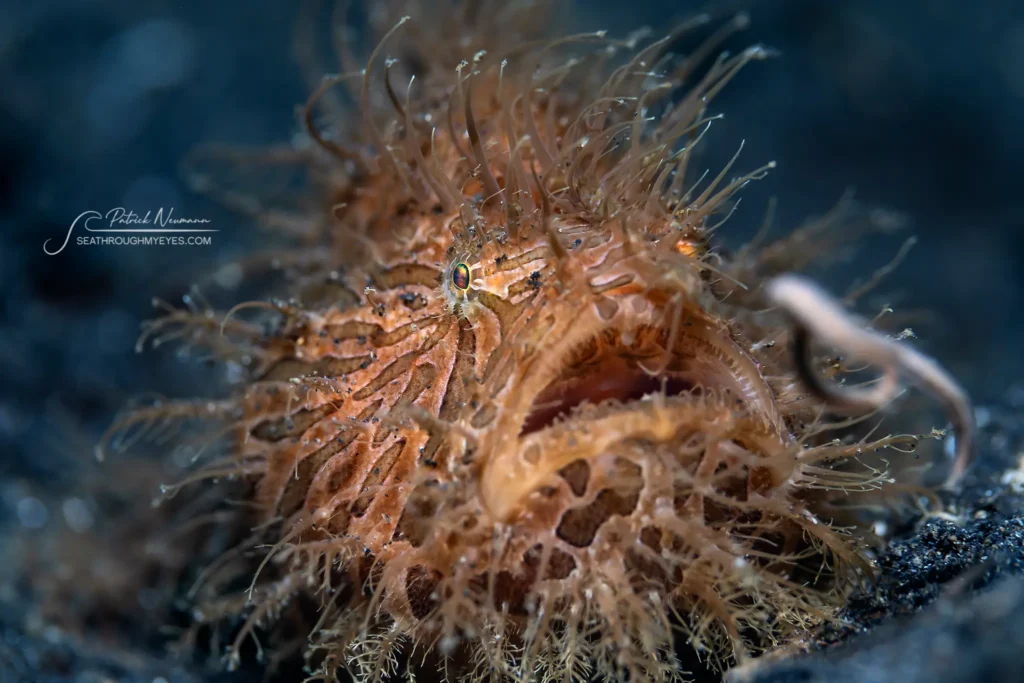
Hairball is one of Lembeh’s most famous muck sites, known for its dark sand slope and scattered bits of debris. It was named after the Hairy Frogfish, a favorite critter here that looks like a fuzzy rock with fins. The site is also known for Ambon Scorpionfish, Coconut Octopuses, and the occasional sea moth.
Hairball is a great place to practice patience. The wide, open layout makes it easier to spot movement, and many animals here stay still long enough for close observation or photos. It’s also one of the few places where you can see multiple species of frogfish on a single dive.
2. Nudi Falls
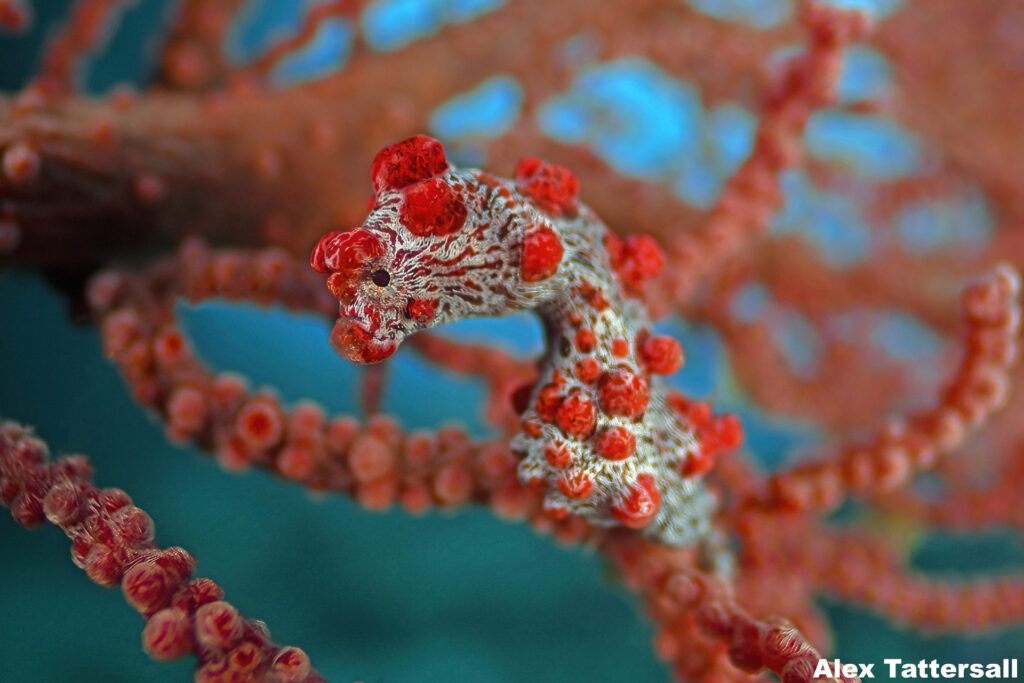
Nudi Falls gets its name from the huge number of nudibranchs found along the wall and rubble slope. This muck diving site starts with a mini wall covered in sea fans and sponges, then drops to a sandy slope that attracts all sorts of macro life. It’s also a reliable place to spot pygmy seahorses, especially on the sea fans growing along the wall.
Besides nudibranchs, you might find frogfish hiding in soft coral patches or Rhinopias resting at the base of the slope. Nudi Falls is also close to the surface, so you can spend more time here with great lighting, perfect for macro photography without deep water stress.
3. TK (Teluk Kembahu) 1, 2, and 3
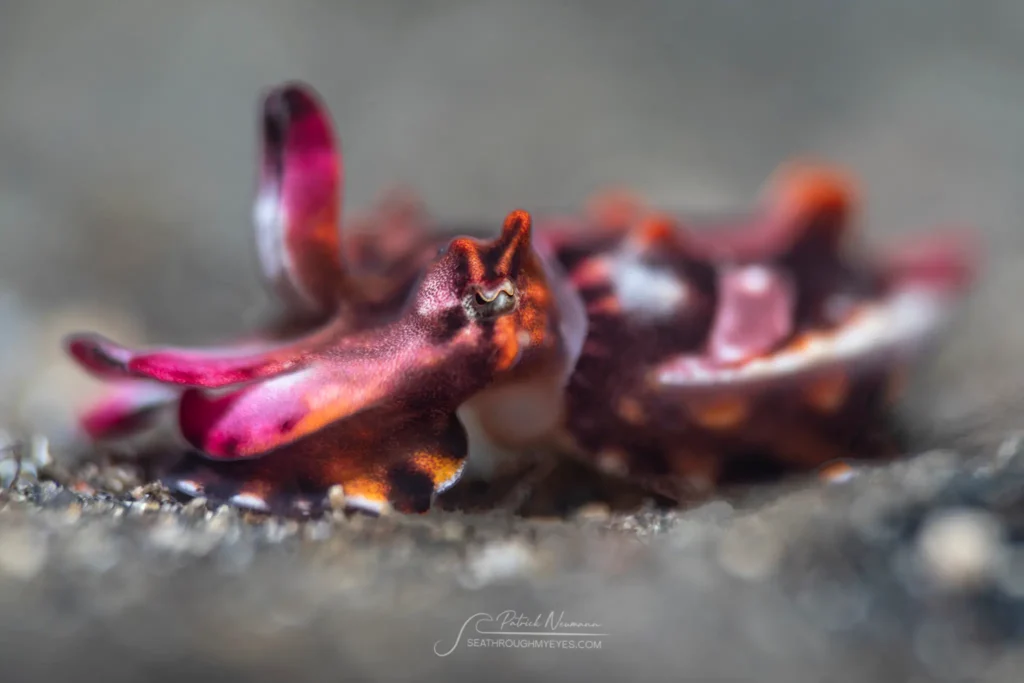
The TK sites are shallow, silty bays that sit just in front of a small fishing village. “TK” stands for Teluk Kembahu, which means “Kembahu Bay” in Indonesian. These are the original discovery sites for the Mimic Octopus, which was first filmed here performing its famous shape-shifting behavior.
In addition to Mimics, TK is also home to Wunderpus, Flamboyant Cuttlefish, and various types of shrimp and seahorses. The soft mud makes it easy for animals to dig, hide, and feed, offering some of the best chances to see rare behaviors up close.
4. Jahir 1
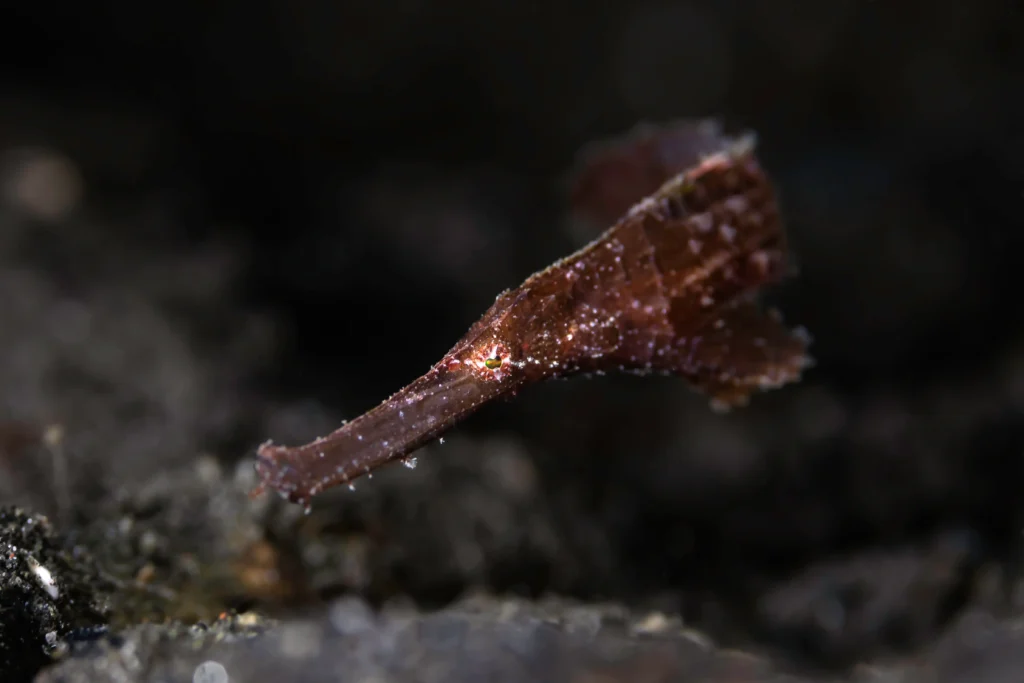
Jahir 1 is named after a local dive guide who first explored and mapped the site. It has a gentle sand slope with scattered rubble and is popular for sightings of mimic octopuses, flamboyant cuttlefish, and ghost pipefish. It’s also a favorite spot for rare nudibranchs.
The beauty of Jahir 1 is its natural and untouched ecosystem. The sand is soft and clean, and the dive is shallow enough to allow long bottom time. This makes it ideal for slow, quiet dives where you can really focus on what’s hiding in plain sight.
5. Nudi Retreat
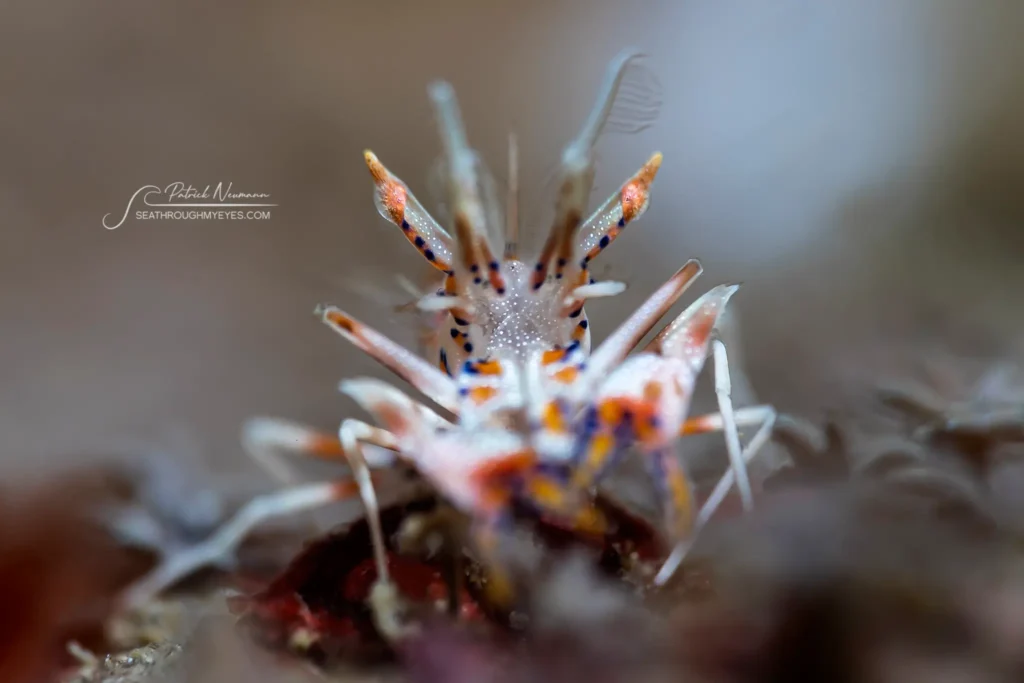
Nudi Retreat gets its name from the large number of nudibranchs that used to be found near the shallow coral garden at the end of the dive. It features a mix of reef and muck terrain, with sandy slopes leading into coral patches. It’s a great site for spotting Bargibanti and Harlequin Shrimp, along with electric clams and even reef fish.
What’s special about Nudi Retreat is the change in scenery during the dive. You might start in the sand looking for frogfish, then finish your dive exploring coral heads for seahorses or spotting a passing ray. It’s one of the more diverse sites in Lembeh and works well for groups with mixed experience or interests.
Best Time to Go Muck Diving in Lembeh
One of the best things about diving in Lembeh is that it’s great all year. The strait is narrow and protected, so there’s little current and rarely any strong wind. That means dive conditions stay calm and clear most of the time, no matter the season.
From July to October, the water cools down to around 25–26°C (77–79°F). Many critters move into shallower water during this time, which makes them easier to find and photograph. This is often called “peak critter season” because the chances of spotting rare species are higher on nearly every dive.
From November to June, the water warms up to about 28–29°C (82–84°F). Some animals may go slightly deeper, but you’ll still find plenty in easy diving range. Visibility often improves during these months, especially between October and December, when the water tends to be clearest.
No matter when you visit, Lembeh delivers. If you prefer cooler dives and more critter action, come in peak season. If you like warmer water and fewer crowds, the rest of the year is just as rewarding.
4 Tips to Prepare for Your Muck Dive

Lembeh’s diving conditions are calm and gentle, but getting the most out of each dive takes a bit of practice. With a few key skills and the right gear, your dives will be smoother, longer, and far more rewarding. Here are some of the things you can prepare:
- Control your buoyancy: Good buoyancy keeps the sand from getting stirred up and helps protect marine life. Practice hovering and use a gentle frog-kick to keep your fins away from the bottom.
- Use Nitrox if possible: Since muck dives are long and usually shallow, Nitrox gives you more time underwater without hitting your no-deco limits.
- Bring a strong dive light: Even in daylight, a good light helps you see into holes and under debris. It also brings out the real color of camouflaged critters.
- Consider a pointer stick: A small metal stick helps you stay steady near the bottom without using your hands. It’s also used by guides to point out small animals without touching them.
Being prepared also means diving responsibly. With the right habits, you’ll dive more confidently and get much more out of each muck dive.
Photography Techniques for Lembeh’s Muck
Lembeh is one of the best places in the world for underwater photography. The dark sand acts like a natural backdrop, making your subject stand out. But getting great shots here takes a few specific techniques and some practice.
Here are some techniques you can try to get that perfect shot:
- Get low: Shoot at the same level as your subject, not from above. This helps create a more natural and eye-catching image.
- Use a snoot: A snoot focuses your strobe light into a narrow beam. This lets you light only the critter, leaving the background dark and clean.
- Control your background: A fast shutter speed and small aperture help cut out ambient light. This makes your subject pop against a black background.
The goal is to isolate your subject and keep the photo clean and focused. With time and practice, these simple techniques can turn a good photo into a great one, especially in a place like Lembeh..
Where Should You Stay for the Best Muck Diving Experience in Lembeh?

Choosing the right dive resort matters, especially in a place like Lembeh, where each dive will be unique and different. When your goal is to find rare marine life and enjoy every moment underwater, your surface time should be just as rewarding.
At Solitude Lembeh Resort, that experience continues after the dive. After exploring the sand with our PADI-certified dive instructor who knows exactly where to look, you’ll come back to a freshly prepared home-cooked meal. You can relax on the deck with the sea breeze, review your photos in our camera room, or just enjoy the quiet and relaxed atmosphere.
Book your stay at Solitude Lembeh Resort and dive into comfort, focus, and world-class muck diving in one of the best places on earth!